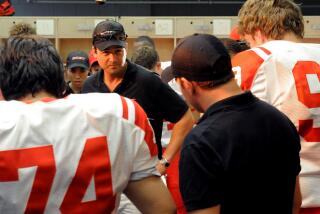Exhibit Bares the Truth About the Aging Process
Ojai-based sculptor Richard Matzkin has broken with tradition in the series of figurative pieces he candidly calls “Naked Old Men.” These pieces in clay and bronze, shown this month at the Ojai Arts Center, deal directly with the physical nature of the subjects--in all their flabby non-glory.
In so doing, Matzkin is also questioning definitions, specifically the naked-versus-nude distinction in art. Lithe, young females can be nude, or so goes the archetype, but old men must necessarily be naked--lumpen flesh, pot-bellied and slack-jowled specimens past their prime.
Matzkin depicts men in assorted positions: slumped into an easy chair, for instance, or scrunched into a lotus position. Another man is curled up in a fetal position, as if approaching existential full circle.
These figures are not beautiful in the classic, socially acceptable sense, but Matzkin extends respect by showing them with honesty and focus. In his own way, Matzkin illustrates the way of all flesh, acknowledging that it is nature’s way and therefore is innately beautiful, despite what society would have us believe.
In the center’s main gallery this month, there is a show called “Metamorphosis of a Drawing,” demonstrating the fruits of the drawing process. On one wall hangs a series of hasty sketches and drawings--works-in-progress or maybe just works-in-process.
Elsewhere in the gallery are more finished paintings, a few of which call out for attention. Art historical heroes come to haunt in pieces like Betty Saunders’ “The Model After Gaugin” and Marta Nelson’s “Quasi-Klimt.”
Blanche McBroom captures a sensuous delicacy in her watercolor “Alice,” and Norman Kirk goes for a more fastidious mode of portraiture, though on a fantasy theme, with his “Court Jester.”
Alice Matzkin’s “Aunt Kitty’s Hand,” a complement to husband Richard’s sculptures, captures the quiet dignity of the aged by focusing on the hand of an elderly woman. The success of the art is in the editing, on the discrimination of hand and eye.
* “Metamorphosis of a Drawing” and Richard Matzkin’s “Naked Old Men,” through January at the Ojai Arts Center, 113 S. Montgomery St. Gallery hours: noon-4 p.m. Tuesdays-Sundays; 646-0117.
*
Banking on Art: Bank Art, a close relative of Corporate Art and a more button-down sibling of Restaurant Art, is often a specialized field, requiring work that neither jars viewers nor takes their minds off of matters at hand. Bank patrons, as a rule, don’t like to be alarmed or even challenged. And that’s reasonable.
That said, one doesn’t go to the Bank of A. Levy Art Collection, at the Ventura County Museum of History and Art, with expectations of discovering cutting-edge visions.
What one finds, however, is a pleasantly surprising collection of pieces, extending from the gallery to the back hallway, that celebrates the artistic pulse as defined by Ventura artists.
The work ranges from Gail Pidduck’s “Beasley Barn,” an agrarian scene with light settling gently on the good Earth, to Amani Fliers’ “Triangles,” a soft-edged conceptual piece--variations on the theme of coat hangers. The late local heroine Jesse Arms Botke’s “Still Life With Eggplant” is mild mannered compared to her more flamboyant paintings.
Within limits, there are contemporary ideas afloat here, such as Norma Krahn’s “East Lake, West Lake,” a whimsically titled diptych of a swimming pool-wet culture.
The fascinating local painter Suzanne Schechter’s “Boy in Pool” is like a snapshot revisited and retooled, with iridescent reflections and rippling water rendered with a free palette.
All in all, not bad for a Bank Art Collection. Check your stereotypes at the door.
* Bank of A. Levy Art Collection, through January at the Ventura County Museum of History and Art, 100 E. Main St., in Ventura. Gallery hours: 10 a.m.- 5 p.m. Tuesdays-Sundays; 653-0323.
*
Living Room Art: R.M. Schindler was among the handful of significant architects who put Los Angeles on the international map starting in the ‘20s. With the International Style, Schindler and cohorts charted a course for modernism, right here in our midst.
The challenge of integration, which evolved from Frank Lloyd Wright, was a driving obsession for Schindler and for Richard Neutra--a fellow European emigre to L.A., and a comrade and a competitor.
The challenge became one of integrating interior and exterior spaces and creating useful, graceful “machines for living.” Some found this approach cool and detached, others embraced its anti-romantic clarity.
To that end, Schindler did his share of furniture design, intended to be used in conjunction with his architectural designs.
The show of Schindler’s furniture at the UC Santa Barbara Art Museum is intriguing partly because, taken out of architectural context, the pieces look woodsy and a bit quaint today. Modernism, where is thy sting?
There is plenty of utilitarian angularity in the design, but the use of warm wood materials and a ground-hugging orientation give it a sense of earthiness to temper the intellectual buzz.
We gain a valuable perspective by comparing the actual, physical objects with photographs--including some by noted architectural photographer Julius Shulman--taken in the actual structures.
This exhibition is presented as a tribute to architectural historian David Gebhard, whose unexpected death last year left a void in the region’s architectural circle.
Gebhard’s architectural drawings, held at the university, are a residual legacy of his work. More than perhaps any other figure in the area, Gebhard sparked our awareness of the architectural and historical riches that Southern California has to offer.
* “The Furniture of R.M. Schindler,” through Feb. 2 at UC Santa Barbara Art Museum. Gallery hours: 10 a.m.-4 p.m. Tuesdays-Saturdays, 1-5 p.m. Sundays. 893-2951.
More to Read
The biggest entertainment stories
Get our big stories about Hollywood, film, television, music, arts, culture and more right in your inbox as soon as they publish.
You may occasionally receive promotional content from the Los Angeles Times.






